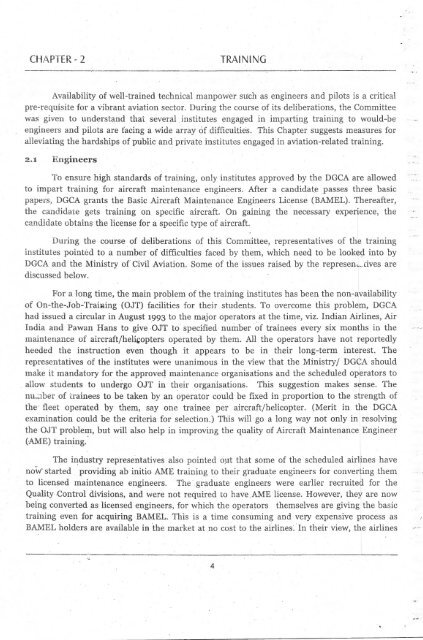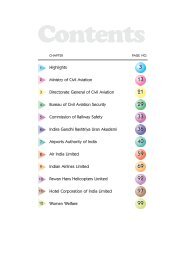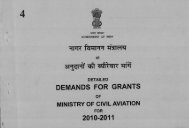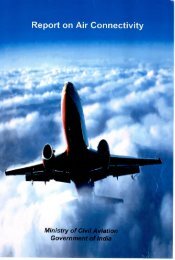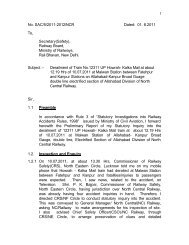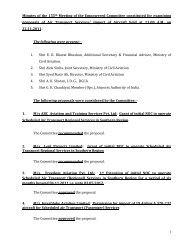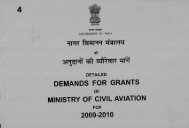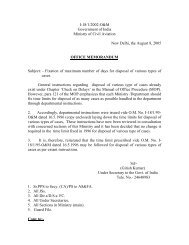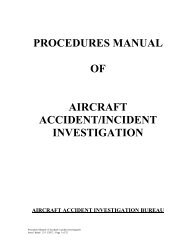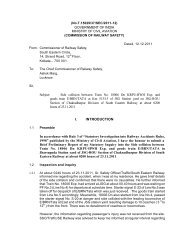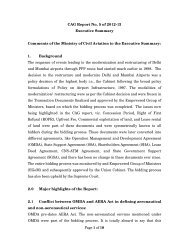3 - Ministry of Civil Aviation
3 - Ministry of Civil Aviation
3 - Ministry of Civil Aviation
Create successful ePaper yourself
Turn your PDF publications into a flip-book with our unique Google optimized e-Paper software.
CHAPTER - 2TRAININGAvailability <strong>of</strong> well-trained technical manpower such as engineers and pilots is a criticalpre-requisite for a vibrant aviation sector. During the course <strong>of</strong> its deliberations, the Committeewas given to understand that several institutes engaged in imparting training to would-beengineers and pilots are facing a wide array Of difficulties. This Chapter suggests measures foralleviating the hardships <strong>of</strong> public and private institutes engaged in aviation-related training.2.1 EngineersTo ensure high standards <strong>of</strong> training, only institutes approved by the DGCA are allowedto impart training for aircraft maintenance engineers. After a candidate passes three basicpapers, DGCA grants the Basic Aircraft Maintenance Engineers License (BAMEL). Thereafter,the candidate gets training on , specific aircraft. On gaining the necessary experience, thecandidate obtains the license for a specific type <strong>of</strong> aircraft.During the course <strong>of</strong> deliberations <strong>of</strong> this Committee, representatives <strong>of</strong> the traininginstitutes pointed to a number <strong>of</strong> difficulties faced by them, which need to be looked into byDGCA and the <strong>Ministry</strong> <strong>of</strong> <strong>Civil</strong> <strong>Aviation</strong>. Some <strong>of</strong> the issues raised by the represen,...cives arediscussed below.For a long time, the main problem <strong>of</strong> the training institutes has been the non-availability<strong>of</strong> On-the-Job-Training (OJT) facilities for their students. To overcome this problem, DGCAhad issued a circular in August 1993 to the major operators at the time, viz. Indian Airlines, AirIndia and Pawan Hans to give . OJT to specified number <strong>of</strong> trainees every six months in themaintenance <strong>of</strong> aircraft/helicopters operated by them. All the operators have not reportedlyheeded the instruction even though it appears to be in their long-term interest. Therepresentatives <strong>of</strong> the institutes were unanimous in the view that the <strong>Ministry</strong>/ DGCA shouldmake it mandatory for the approved maintenance organisations and the scheduled operators toallow students to undergo OJT in their organisations. This suggestion makes sense. Therm.:11)er <strong>of</strong> trainees to be taken by an operator could be fixed in proportion to the strength <strong>of</strong>the'' fleet operated by them, say one trainee per aircraft/helicopter. (Merit in the DGCAexamination could be the criteria for selection.) This will go a long way not only in resolvingthe OJT problem_ , but will also help in improving the quality <strong>of</strong> Aircraft Maintenance Engineer(AME) training.The industry representatives also pointed out that some <strong>of</strong> the scheduled airlines havenow started providing ab initio AME training to their graduate engineers for converting themto licensed maintenance engineers. The graduate engineers were earlier recruited for theQuality Control divisions, and were not required to have,AME license. However, they are nowbeing converted as licensed engineers, for which the operators themselves are giving the basictraining even for acquiring BAMEL. This is a time consuming and very expensive process asBAMEL holders are available in the market at no cost to the airlines. In their view, the airlines


